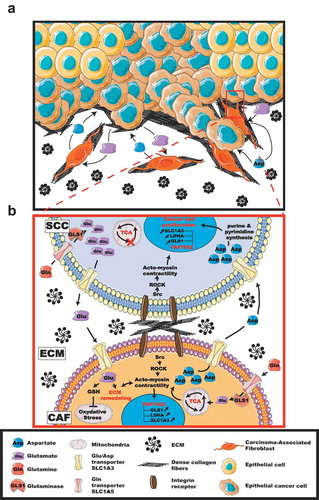Figures & data
Figure 1. Mechanical regulation of the metabolic network that drives tumor progression by interfacing cancer and stromal cells. Extracellular matrix (ECM) remodeling by Carcinoma-Associated Fibroblast (CAF) within the tumor microenvironment promotes matrix stiffening. Stiffer matrix, in turn, favors epithelial cancer cell proliferation and metastatic spreading (A). Mechanical activation of the YAP/TAZ-dependent transcriptional program in cells results in increase of the glutaminase (GLS), lactate dehydrogenase A (LDHA) and aspartate/glutamate transporter SLC1A3 genes, thus coordinates glycolysis and amino acid availability within the tumor niche. Mechanistically, in epithelial cancer cells, this mechanical response results in glutamate accumulation accompanied by a defect of the TCA cycle and an impaired production of aspartate. In stromal fibroblasts, the mechanically regulated accumulation of glutamate leads to production of aspartate and control of acto-myosin-dependent ECM remodeling. Finally, the aspartate produced by the stromal fibroblasts is released within the tumor microenvironment and uptaken by the tumor cells to supply their proliferative needs. While the glutamate produced by the cancer cell is released within the tumor microenvironment and uptaken by the stromal fibroblasts to balance their redox level which appear key for their remodeling activity. In summary, mechanical activation of YAP/TAZ in the tumor niche coordinate cancer cells proliferation and stromal fibroblasts-dependent ECM remodeling with their energetic and biosynthetic requirements to force metastatic spreading (B). SCC: squamous cell carcinoma.

